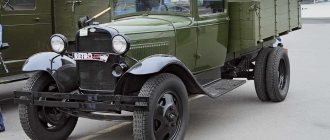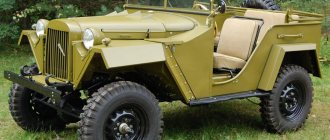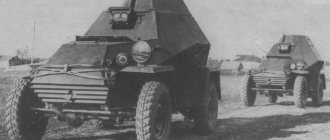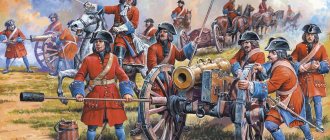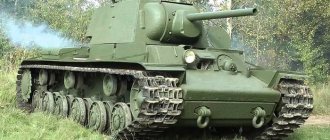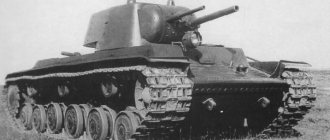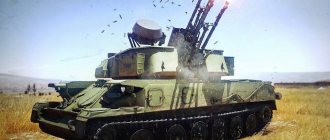During the years of its existence, the famous Likhachev plant purchased foreign cars, after which specialists analyzed each car comprehensively. At that time, special preference was given to American cars, so one could always discern overseas features in ZiL and ZiS passenger cars.
The ZIL-111 limousine was also no exception, and you can easily find something from American cars in it. In the 60s of the last century, the ZIL-111 car was widely used: it was the one that carried cosmonaut Yu.A. Gagarin from the airport to the Kremlin after performing the world's first space flight.
History of the development of ZIL-111
The history of the famous limousine from the Likhachev plant began in the late 1940s, when the famous ZIS-110 became outdated compared to its foreign counterparts. In this regard, the first serious modernization was undertaken in 1948.
The modernized car was technically no different from the base model, but its body received a completely different shape, copied from the American Packard of the 1948 model year. Even then, the new model was unofficially called ZIS-111, but it was only a prototype.
The ZIS-110 continued to be produced until 1958 (in 1956 it was renamed ZIL-110), but work on creating a completely new executive class limousine was in full swing. Already in 1956, designers were able to put on public display the prototype ZIS-111 “Moscow”, which debuted at the All-Union Agricultural Exhibition. Despite the fact that the development used the advanced achievements of the American automotive industry, and the body of the new car resembled the Cadillac and Buick of those years, the car was unable to attract the attention of viewers.
The car turned out to be outwardly inconspicuous and unmemorable, so the management of the ZIL plant announced a competition for the best development of a new car. In addition to the “Moscow” limousine, which was almost ready for mass production, which was developed by Rostkov, the project of the designer from the Gorky Automobile Plant Eremeev was worthy of attention. This man worked on the creation of the GAZ-21 and ZIM-13, better known as the “Chaika”.
Naturally, when creating the project for the ZIL-111 car, Eremeev started from his already completed sketches, which he made at the GAZ plant. However, he managed to develop a car that was different from the Chaika both externally and structurally.
External similarity of Soviet cars with the best American models
Even before the start of the Great Patriotic War, Soviet automobile factories purchased the best examples of the American automobile industry, trying to copy their main components. After the war, when the equipment supplied under Lend-Lease proved its reliability, this process became widespread. Since 1950, ZIL has acquired the following models from the US auto industry for study:
- Several Buicks of various years;
- Two Lincoln Cosmopolitans;
- Several Cadillacs;
- Packards;
- Plymouths;
- Chryslers of various modifications.
All these gorgeous samples were carefully studied and then transferred to US. Nowadays it’s hard to believe, but post-war Soviet cars were created taking into account the latest trends in the global automotive industry.
One should not assume that Soviet design engineers blindly copied American models; their proportions and technical equipment could have been completely different. But as for the design, the appearance of the ZIL-11 immediately reveals the “family” features of the Packard limousine family.
Cars began to be mass-produced in 1958, but in 1962 it was decided to modernize them externally. The new ZIL-111G received an updated front design, which was an almost complete copy of the latest cars.
Overseas prototypes
The new model had more modern lines, the body was copied in parts from several American models of the middle and upper category: Cadillac, Buick and Packard. However, in general, the car’s exterior left much to be desired, the design was not impressive, and it did not have that necessary zest that makes a luxury car stylish and impressive.
A design competition was announced, which resulted in several new solutions. All of them were based on American models of the early 50s. At that time, it was considered good form to copy foreign analogues, but the similarity had to be within certain limits, otherwise the Americans would face licensing claims.
In the end, ZIL-111 was approved, and the car began to be assembled at a separate experimental site. It was decided to create several test samples and then launch the model into a limited series. The main difficulties arose when stamping the tail, since the dimensions of the front and rear wings of the car were beyond the usual dimensions. We had to create exclusive equipment and use it to manufacture external design details.
Description of design
The design of the ZIL-111 car is based on a frame assembled from stamped elements by welding or rivets. An X-shaped amplifier is placed in the center, the front side members have a box-shaped design. The front wheels of the limousine are mounted on an independent wishbone suspension with double-acting shock absorbers and a stabilizer bar. The rear axle beam is mounted on semi-elliptical leaf springs with additional shock absorbers.
The steering of the ZIL-111 car is equipped with a hydraulic booster, the power cylinder control spool is installed in the gearbox.
The brake mechanisms of all wheels of the limousine are drum-type with a vacuum booster in the drive. Mechanical parking brake.
The ZIL-111 limousine has a closed 4-door body, inside of which there are 7 seats for passengers and the driver. The middle row, designed for 2 people, can be folded, increasing the free legroom for people in the rear sofa. The front row of limousine seats is separated from the rest of the cabin by a transparent partition that can be lowered down. The car body is mounted on the frame using a large number of bolts and rubber cushions.
The windshield and rear windows of the ZIL-111 limousine are made panoramic, and electric window lifters are used in the doors. Additional ventilation of the ZIL-111 car interior is carried out through the rotary windows of the front doors and sliding windows located in the rear roof pillars.
To ensure comfort, a climate control system with air conditioning is used (model ZIL-111A).
The vehicle heating system includes two independent radiators connected to the engine cooling system. The air conditioner, charged with freon, is located in the luggage compartment. The unit is equipped with an individual fan; cooled air is forced into the cabin through channels located in the corners of the rear upper part of the body.
The ZIL-111 car was equipped with an 8-cylinder 4-stroke carburetor engine with a cast-iron crankcase, with a volume of almost 6 liters, to be precise - 5.969 liters. Two rows of cylinders are arranged in a V-shape at an angle of 90⁰. The stamped pan is attached to a plane located below the axis of the crankshaft, which increased the rigidity of the structure.
The block heads are made of aluminum, each cylinder has 2 valves with a rod drive from a common camshaft installed in the camber of the cylinder banks. The pistons are cast from aluminum alloy and have a special coating.
The power unit of the ZIL-111 car develops a power of 200 hp. (in some sources - 220 hp) at 4200 rpm, the compression ratio increased to 9.0 required the use of gasoline with an octane number of at least 92.
Consumption – 29/100. The fuel supply is located in a tank with a capacity of 120 liters, which is installed in the rear of the ZIL-111 limousine. To supply the fuel mixture, a 4-chamber K-85 carburetor is used, equipped with an automatic temperature regulator based on a bimetallic spring.
The mixture composition is adjusted automatically; to start a cold engine you just need to turn the key in the ignition. Exhaust gases are released through two pipelines with individual mufflers.
The radiator of the cooling system of the ZIL-111 car is equipped with additional red copper strips placed in the fan blowing area. A steel diffuser is used to enhance the air flow passing through the honeycomb. In front of the radiator of the limousine there are blinds with automatic control from a separate thermostat. An additional radiator is located on the pump body, which serves to cool the automatic transmission oil. The design of the ZIL-111 car provides a separate radiator for cooling the oil.
To change the torque, an automatic transmission is used, consisting of a 1-speed hydraulic transformer and planetary gears, providing 2 forward speeds and reverse. Switching of stages is carried out by friction mechanisms with an electro-hydraulic drive.
The driving mode is selected using a push-button switch installed on the instrument panel.
The output shaft of the ZIL-111 gearbox and the flange of the rear drive axle are connected by 2 cardan shafts with an additional support. The end of the front shaft has a sliding spline connection. The main hypoid pair and the 2-pinion differential are located inside the steel axle beam. The wheels of the ZIL-111 are equipped with a decorative chrome cap with ventilation blades, which improve the cooling of the brakes and tubeless tires of size 8.90*15.
Power point
The ZIL-111 engine is atmospheric, carburetor, and runs on AI-93 gasoline.
- The total volume of cylinders is 5969 cubic meters. cm.
- Configuration - V8.
- Number of cylinders - 8.
- Number of valves - 16.
- The valve mechanism is OHV type.
- Cylinder diameter - 100 mm.
- Compression ratio - 9.
- The piston stroke is 95 mm.
- The power supply system is a K-85 carburetor, four-chamber.
- Power - 200 horsepower.
- The material of the cylinder heads is aluminum.
- The cylinder block is cast iron.
Technical characteristics and design of ZIL-111
Initially, the engineers planned to take the chassis of American products as a basis, and put a body with an updated design on them. It was not possible to implement the idea due to the dimensions of the engine, so we had to make our own changes. The long powerplant of the old generation was replaced with a V-twin to reduce the load on the front wheels.
Specifications:
- Length - 6,140 millimeters;
- Width - 2,040 millimeters;
- Height - 1,640 millimeters;
- Ground clearance - 180 millimeters;
- The volume of the power plant is 6 liters;
- Power unit power - 200 horsepower;
- Transmission - automatic;
- Drive - rear;
- Maximum speed - 170 km/h;
- The volume of the fuel tank is 120 liters.
Motor
The new ZIL-111 engine has become one and a half meters shorter due to the two-row arrangement of eight cylinders. Weight was reduced by using aluminum in the production of pistons and reducing the number of crankshaft journals from 8 to 4 (this was achieved by placing two connecting rods on one journal). The volume of one cylinder is 5.969 liters. At 4,200 rpm, a power of 200 horsepower is achieved, which is 60 more than the 110th model.
Power was increased by increasing compression and improving the filling of the cylinders with fuel (the exhaust pipes were shortened, and the cylinder heads were equipped with overhead valves). The use of a new generation K-85 carburetor played an important role in improving power. It consisted of four chambers. They began to work one after another depending on the speed of the transport. This design solution reduced fuel consumption when driving in the city and increased the maximum speed to 170 km/h.
A special feature of the ZIL-111 car was its automatic transmission. It was called new, but before that it was equipped with a small series of the 21st Volga. After that it was also used on Chaika.
Dimensions
When creating the car, the designers tried to reduce the height, but leave the ground clearance the same. Also an important detail was the placement of seats for passengers inside the wheelbase. The reduction in height improves road holding and aerodynamics at high speeds. The rear sofa has been increased in size.
Power steering
Power steering was added to the ZIL-111 design. This became a novelty for domestic passenger transport. It made turning the steering wheel four times easier. Driving a car with this addition has become easier. The power steering also added comfort - when driving over bumps, no shocks were felt in the steering wheel.
The power steering device included a power cylinder, a control spool and an oil pump, which were connected to the steering mechanism. A double-acting vane oil pump was installed in the front of the engine. A belt drive from the crankshaft pulley was responsible for its operation.
Brake system
It consisted of two systems - foot and manual. Thanks to them, the driver could brake with a minimum braking distance even at high speed. The foot mechanism affected all wheels. It was complemented by a hydraulic drive with a booster, which reduced the effort required from the driver when pressing the brake pedal. One cylinder was responsible for the operation of the rear pads, and two cylinders were responsible for the operation of the front ones.
Chassis
ZIL-111 cars are designed for low speeds. According to their purpose, the cars should move in a government motorcade around the city, go to Red Square at the May 9th festive parade, and represent when meeting distinguished guests at the airport. Vehicle use is limited.
Nevertheless, the chassis of the car has a huge margin of safety. This potential is necessary so that the transport serving the top officials of the state does not fail, refuse or fail at the most inopportune moment. The heavy-duty frame chassis of the vehicle carries a multi-link front independent suspension with a torsion bar, steel springs and reinforced hydraulic shock absorbers.
The rear suspension is dependent, on semi-elliptic springs, also with hydraulic shock absorbers. The rear axle, equipped with a planetary gear with a differential, of a continuous design, is connected to the transmission via a two-section driveshaft. The hypoid gearing pair ensures silent operation of the entire rear suspension. The running gear was only audible when moving in reverse.
Various modifications of the ZIL-111 limousine
ZIL-111 in its original form was produced until 1962. Starting from this year, over the next four years, a modification of the ZIL-111G was produced. This car was created thanks to the rapidly developing North American automobile industry. In the early 1960s, cars with an abundance of chrome parts and massive air intake grilles became fashionable in the United States.
The updated ZIL received the following changes:
- New windshield shape;
- Round taillights;
- Moldings of a new form;
- More powerful and high-torque engine.
Convertibles were also produced based on the updated limousine. They received the index ZIL-111D. The first convertible was created six months after the debut of the updated model. A few months later, this car was presented to Fidel Castro, who came to Moscow on a friendly visit. Nikita Sergeevich Khrushchev himself handed the keys to the car to the Cuban leader.
After some time, several more open ZIL-111Ds were assembled, four of them were intended for ceremonial military parades. The general public was able to see these cars only in 1967, when the 50th anniversary of the revolution was celebrated. Before this, there was simply no need for them, since previous modifications of convertibles were in service, which were used several times a year and were in perfect condition.
According to official data, during the entire production of ZIL-111, about 115 vehicles were assembled. How many of them have survived at present is unknown. Very rarely they appear on sale, but the price can reach up to $100,000.
Interesting Facts
Regarding the ZIL-11D phaeton, it can be noted that three cars were made strictly in black. One copy was sent to the GDR, its further fate is unknown. The remaining two limousines stood for a long time within the walls of the plant. The gray-blue counterparts have a more cheerful history; they periodically appeared in parades for a long time.
The phaeton went to Red Square for the first time in 1967 (a parade dedicated to the fiftieth anniversary of the October Revolution). Several cars under the index 114 were prepared for this date, but these government limousines did not make it to the event.
The leader of the USSR, Nikita Khrushchev, gave one phaeton to Comandante Fidel Castro from the bottom of his heart. The ruler of Cuba returned home by plane, and the present took a long time to reach its destination by sea. Upon arrival on the island, ZIL-111 was solemnly handed over to Fidel for use, and the event was led by Ambassador Alekseev from the Union.
Application
ZIL-111 limousines were used as government cars for transporting top officials of the USSR and high-ranking foreign delegations. Convertibles were used during parades, as well as during various special events. Thus, the open car ZIL-111V was the transport for the first cosmonaut Yu.A. Gagarin - in this car he was taken from the airport to the Kremlin.
Some of the cars were transferred to the allies of the USSR, for example, the Cuban leader F. Castro had a ZIL-111V convertible, donated by the then leader of the country N.S. Khrushchev. At least one car was available in the GDR and served the head of the GDR, Erich Honecker. Decommissioned limousines were supplied to wedding palaces, where they were used back in the early 80s.
Closely related to the ZIL-111 limousine is the ZIL-118 minibus, which was an attempt to make the production of government vehicles profitable.
The bus used a power unit and transmission from a passenger car; the body had a completely original design. The car never made it into production, but was built in single copies until the early 90s.
Another original development based on the components of the ZIL-111 limousine was the ZIL-112S 2-seater sports car, assembled in 1962. The first version was equipped with a fiberglass body and a gasoline engine with increased power (due to the compression ratio).
Subsequently, the body was changed to an aluminum structure, which was originally installed on the second prototype. The cars were used at union-level competitions until the early 70s. One copy of the ZIL-112S racing car, which is located in Riga, has survived to this day.
What can be concluded?
ZIL-111 is a premium car of the USSR. It was remembered by many residents of the socialist period and was used by the country's leading leadership. Many people dreamed of such a machine, but it was beyond reality due to its small-scale production and clear purpose for certain government agencies. Some copies have survived to this day; they are kept in private collections and are worth a lot of money. People try to find cars in poor condition in order to restore them to their original condition.
